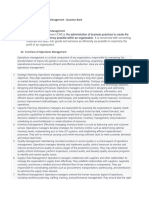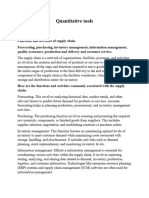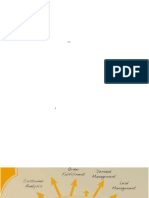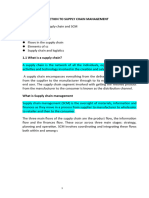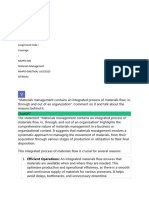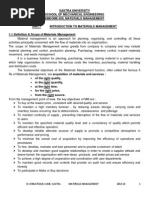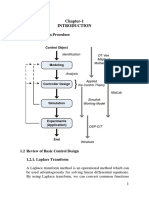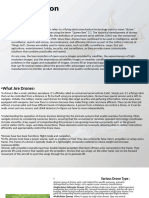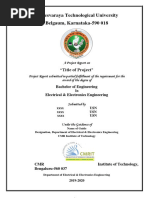0 ratings0% found this document useful (0 votes)
19 viewsOperations Management
Operations Management
Uploaded by
heyzzzThe document discusses objectives related to operations management. It defines supply chain management and lists its objectives as reducing costs, improving quality, and enhancing flexibility. Logistics management aims to ensure efficient transportation and effective inventory management. Scheduling seeks to optimize resources and control costs. Maintenance and reliability objectives are to keep equipment functioning reliably and efficiently.
Copyright:
© All Rights Reserved
Available Formats
Download as DOCX, PDF, TXT or read online from Scribd
Operations Management
Operations Management
Uploaded by
heyzzz0 ratings0% found this document useful (0 votes)
19 views6 pagesThe document discusses objectives related to operations management. It defines supply chain management and lists its objectives as reducing costs, improving quality, and enhancing flexibility. Logistics management aims to ensure efficient transportation and effective inventory management. Scheduling seeks to optimize resources and control costs. Maintenance and reliability objectives are to keep equipment functioning reliably and efficiently.
Original Title
Operations Management (1)
Copyright
© © All Rights Reserved
Available Formats
DOCX, PDF, TXT or read online from Scribd
Share this document
Did you find this document useful?
Is this content inappropriate?
The document discusses objectives related to operations management. It defines supply chain management and lists its objectives as reducing costs, improving quality, and enhancing flexibility. Logistics management aims to ensure efficient transportation and effective inventory management. Scheduling seeks to optimize resources and control costs. Maintenance and reliability objectives are to keep equipment functioning reliably and efficiently.
Copyright:
© All Rights Reserved
Available Formats
Download as DOCX, PDF, TXT or read online from Scribd
Download as docx, pdf, or txt
0 ratings0% found this document useful (0 votes)
19 views6 pagesOperations Management
Operations Management
Uploaded by
heyzzzThe document discusses objectives related to operations management. It defines supply chain management and lists its objectives as reducing costs, improving quality, and enhancing flexibility. Logistics management aims to ensure efficient transportation and effective inventory management. Scheduling seeks to optimize resources and control costs. Maintenance and reliability objectives are to keep equipment functioning reliably and efficiently.
Copyright:
© All Rights Reserved
Available Formats
Download as DOCX, PDF, TXT or read online from Scribd
Download as docx, pdf, or txt
You are on page 1of 6
Operation Management final
exam
1.Define Supply Chain Management.
● Supply management is the process of managing the flow of
goods and services from suppliers to customers. It involves
coordinating and optimizing the various activities and
processes involved in sourcing, procurement, production,
inventory management, and logistics. Supply Chain
Management is a key function in modern business that
involves managing the entire supply chain from raw
materials to finished products, and ensuring that the right
products are delivered to the right place at the right
time, in the right quantity and quality, and at the right
cost. Effective supply management can help organizations
achieve their strategic objectives, increase customer
satisfaction, and gain a competitive advantage in the
marketplace.
2. What are the objectives of supply chain management?
● The main goals of supply chain management are to reduce
costs, improve quality, increase efficiency, enhance
flexibility, and mitigate risks. By achieving these
objectives, supply chain management can help organizations
to:
Increase customer satisfaction by providing products that
meet or exceed their expectations in terms of quality,
availability, and price.
Improve operational efficiency by reducing waste, improving
productivity, and streamlining processes.
Enhance supplier relationships by building strong
partnerships based on mutual trust, respect, and
collaboration.
Manage inventory effectively by balancing the costs of
holding inventory with the costs of stockouts or shortages.
Mitigate risks by identifying potential disruptions and
implementing strategies to mitigate or prevent them.
Gain a competitive advantage by providing superior products
and services that are delivered faster and at a lower cost
than competitors.
Overall, the objectives of supply chain management are to
ensure that an organization's supply chain is efficient,
effective, and agile, and can respond quickly to changing
customer demands and market conditions.
3.What is the objective of logistic management?
The specific objectives of logistics management include:
Efficient transportation: The primary objective of
logistics management is to ensure that goods are
transported efficiently from the point of origin to the
point of consumption. This involves selecting the most
cost-effective transportation mode and route and optimizing
the use of transportation resources.
Effective inventory management: Logistics management aims
to ensure that the right amount of inventory is available
at the right time and place while minimizing the cost of
holding inventory.
Accurate order fulfillment: Logistics management seeks to
ensure that customer orders are fulfilled accurately and on
time, to maximize customer satisfaction and loyalty.
Effective communication: Logistics management aims to
ensure that there is effective communication between all
parties involved in the logistics process, including
suppliers, carriers, and customers.
Continuous improvement: Logistics management seeks to
continuously improve the logistics process through the use
of data analysis, process improvement techniques, and the
adoption of new technologies and best practices.
Overall, the objectives of logistics management are to
ensure that goods are transported efficiently and
effectively, customer orders are fulfilled accurately and
on time, and inventory is managed effectively, to maximize
customer satisfaction, minimize costs, and gain a
competitive advantage in the marketplace.
4.How do we distinguish between supply chain management,
purchasing, and logistic management?
Although supply chain management (SCM), purchasing, and
logistics management are related concepts, they differ in
their scope and focus.
Supply chain management encompasses all the activities
involved in the production and delivery of goods and
services, from the acquisition of raw materials to the
delivery of finished products to customers. SCM is focused
on managing the entire supply chain, including suppliers,
manufacturers, distributors, and retailers, to ensure that
products are delivered to customers in a timely, efficient,
and cost-effective manner.
Purchasing, on the other hand, is focused specifically on
acquiring the goods and services needed to produce finished
products. Purchasing involves activities such as supplier
selection, negotiation, contract management, and supplier
performance monitoring. The objective of purchasing is to
ensure that goods and services are obtained at the right
quality, quantity, and price.
Logistics management is focused on the physical movement of
goods and services from the point of origin to the point of
consumption. Logistics management involves activities such as
transportation, warehousing, inventory management, and order
fulfillment. The objective of logistics management is to
ensure that products are delivered to customers on time and
at the lowest possible cost.
In summary, while supply chain management encompasses all
the activities involved in the production and delivery of
goods and services, purchasing and logistics management are
more specific in their focus. Purchasing is concerned with
acquiring the goods and services needed to produce finished
products, while logistics management is concerned with the
physical movement of products from the point of origin to
the point of consumption.
5. What is the overall objective of scheduling?
Scheduling involves creating a plan that
outlireliabilityquence of tasks, the resources required to
complete them, and the timeline for their completion. The
main objectives of scheduling include:
Time management: The primary objective of scheduling is to
ensure that tasks are completed within the allotted time
frame. This involves creating a realistic timeline that
takes into account factors such as task dependencies,
resource availability, and potential delays.
Resource optimization: Scheduling aims to optimize the use
of available resources, including personnel, equipment, and
materials. This involves assigning resources to tasks in a
way that maximizes their efficiency and minimizes waste.
Cost control: Scheduling aims to minimize the costs
associated with project execution. This involves creating a
budget that takes into account the costs of personnel,
equipment, materials, and other expenses, and ensuring that
tasks are completed within the budgeted amount.
Risk management: Scheduling seeks to mitigate the risks
associated with project execution. This involves
identifying potential risks and developing contingency
plans to address them.
Communication and coordination: Scheduling aims to
facilitate communication and coordination among team
members, stakeholders, and suppliers. This involves
providing regular updates on project progress, identifying
and addressing potential bottlenecks, and ensuring that all
parties are informed and aligned with the project
objectives.
Overall, the objectives of scheduling are to ensure that
projects are completed on time, within budget, and to the
required quality standards, while minimizing risks and
optimizing the use of available resources.
6.What is the objective of maintenance and reliability?
The objective of maintenance and reliability is to ensure
that equipment, machinery, and other assets are kept in
good working condition, and are able to perform their
intended function reliably and efficiently.
Maintenance involves the process of preserving, repairing,
and replacing equipment and machinery to ensure that they
remain in good working order. The main objective of
maintenance is to prevent breakdowns and other types of
equipment failure that can disrupt operations and result in
costly repairs. Additionally, maintenance seeks to extend
the useful life of equipment and machinery by identifying
and addressing potential issues before they become serious,
and minimize downtime by ensuring that equipment is
available when needed.
Reliability refers to the ability of equipment and
machinery to perform their intended function without
failure or interruption. The main objective of reliability
is to improve equipment performance by identifying and
addressing potential sources of failure. Additionally,
reliability aims to reduce maintenance costs by identifying
and addressing the root causes of equipment failure, rather
than simply addressing symptoms. Ultimately, the goal of
maintenance and reliability is to ensure that equipment and
machinery remain in good working condition, operate
reliably and efficiently, and provide a safe and productive
working environment.
You might also like
- Laudon Mis17 PPT Ch10Document39 pagesLaudon Mis17 PPT Ch10muaaz gill100% (2)
- For The Digital Audio System DS-DB Digital Series Distribution Board and Amplifiers ManualDocument56 pagesFor The Digital Audio System DS-DB Digital Series Distribution Board and Amplifiers ManualSISTEMAS INTELIGENTES SA DE CV SitecNo ratings yet
- Operations and Supply Chain ManagementDocument27 pagesOperations and Supply Chain ManagementMahesh KhedkarNo ratings yet
- Supply Chain Management SCMDocument5 pagesSupply Chain Management SCMAce Shernyll Son GallanoNo ratings yet
- Logistics Case Study 1Document11 pagesLogistics Case Study 1Mary Jane ManuelNo ratings yet
- modulefinalsDocument37 pagesmodulefinalsAL Francis AgustinNo ratings yet
- Suppy CainDocument7 pagesSuppy CainRoselda Icaro - BacsalNo ratings yet
- Supply Chain CompleteDocument22 pagesSupply Chain Completeabhishek pathakNo ratings yet
- Supply Chain ManagementDocument14 pagesSupply Chain ManagementengramdadcmoshNo ratings yet
- Unit 6Document23 pagesUnit 6ABHISHEK JBNo ratings yet
- Organization For Materials ManagementDocument60 pagesOrganization For Materials ManagementNaushad PulikkandyNo ratings yet
- MAG-REVIEW NA KAYODocument12 pagesMAG-REVIEW NA KAYOVIRGINIA ALEGRIANo ratings yet
- Intoduction To Supply Chain ManagementDocument32 pagesIntoduction To Supply Chain ManagementKriselle Pearl TonhayNo ratings yet
- ASSIGNMENT Devesh (2019533534)Document13 pagesASSIGNMENT Devesh (2019533534)Devesh GaurNo ratings yet
- SCM HighlightDocument6 pagesSCM HighlightNguyenNo ratings yet
- Quantitative ToolsDocument22 pagesQuantitative ToolsSheku S FofanahNo ratings yet
- Supply Chain ManagementDocument40 pagesSupply Chain ManagementNaman MaheshwariNo ratings yet
- intro1_SCM(done)Document17 pagesintro1_SCM(done)mrpsp8055No ratings yet
- Activities Involved in the ProductionDocument2 pagesActivities Involved in the ProductioninfoNo ratings yet
- Unit1Document28 pagesUnit1rahulparoche251No ratings yet
- OpmanDocument10 pagesOpmanKylle BuenoNo ratings yet
- SCM Notes 1Document6 pagesSCM Notes 1aputoon158No ratings yet
- Mitesh GuptaDocument3 pagesMitesh GuptaB-48 Dev SinghNo ratings yet
- Logistics Unit 1Document14 pagesLogistics Unit 1vikivignesh2331No ratings yet
- Unit - 2Document15 pagesUnit - 2Varun SinghNo ratings yet
- Supply Chain Management Module 1Document7 pagesSupply Chain Management Module 1chaurasiautkarsh700No ratings yet
- Supply Chain Management - Key Terms: AgreementsDocument7 pagesSupply Chain Management - Key Terms: AgreementsSunil DimriNo ratings yet
- coop productionDocument7 pagescoop productionSherymae Cagud AllasNo ratings yet
- Ayush Bba 6th MMDocument39 pagesAyush Bba 6th MMaman.ratre8112004No ratings yet
- Unit 1 SCMDocument30 pagesUnit 1 SCMBsdk TmkcNo ratings yet
- Meaning Logistics ManagementDocument6 pagesMeaning Logistics Managementsheebakbs5144No ratings yet
- Supply Chain ManagementDocument22 pagesSupply Chain ManagementGloria Chinedu IkwuebeNo ratings yet
- Supply Chain & Logistics Management Questions AnswersDocument6 pagesSupply Chain & Logistics Management Questions AnswersAmrita PatilNo ratings yet
- BrailDocument4 pagesBrailbrmo.amatorio.uiNo ratings yet
- Supply Chain Managment IICMDocument35 pagesSupply Chain Managment IICMPartha Pratim SenguptaNo ratings yet
- Materials Management Class Notes PDFDocument76 pagesMaterials Management Class Notes PDFraum123No ratings yet
- Logistics Management: Assignment # 1Document4 pagesLogistics Management: Assignment # 1Writing HelpNo ratings yet
- Supply Chain Management ReportDocument11 pagesSupply Chain Management Reportalan nebridaNo ratings yet
- Logistics MGTDocument28 pagesLogistics MGTJanmejai Bhargava100% (3)
- LCM Cometitive AdvantagesDocument6 pagesLCM Cometitive AdvantagessaisattvaconsultancyNo ratings yet
- Fundamental Principles of Logistics and Supply Chain ManagementDocument7 pagesFundamental Principles of Logistics and Supply Chain ManagementjohnpaulviNo ratings yet
- Distribution Mgmt. Lesson1&2Document5 pagesDistribution Mgmt. Lesson1&2Khaye EdubaladNo ratings yet
- Unit 4 Logistics ManagementDocument6 pagesUnit 4 Logistics Managementadityasaraswat704No ratings yet
- Enabling Task #4Document6 pagesEnabling Task #4Celeste BarriosNo ratings yet
- Logistics ManagementDocument13 pagesLogistics Managementamaanparmar864No ratings yet
- Unit-1 SCMDocument49 pagesUnit-1 SCMuinmbunkiNo ratings yet
- Topic 1 Intro To SCMDocument16 pagesTopic 1 Intro To SCMnyiramahoro ruthNo ratings yet
- Sourcing - Logistics - LEC01 04102023 064133pmDocument31 pagesSourcing - Logistics - LEC01 04102023 064133pm7drkn2vtybNo ratings yet
- Prelim ModuleDocument17 pagesPrelim Modulejohnmark gumbanNo ratings yet
- OPMAN Lesson 7 Script Group 2Document14 pagesOPMAN Lesson 7 Script Group 2Vote ForNikiNo ratings yet
- Mmpo 006Document11 pagesMmpo 006saiharshithanaidu142No ratings yet
- SCM Unit 1&2Document30 pagesSCM Unit 1&2sivaboobalan96No ratings yet
- Module 10Document7 pagesModule 10isabel payupayNo ratings yet
- Ilscm FinalDocument201 pagesIlscm FinalRidwan RijuNo ratings yet
- Supply Chain TransportationDocument8 pagesSupply Chain Transportationa.makhnovaNo ratings yet
- Name - M.Faizyab1-WPS OfficeDocument3 pagesName - M.Faizyab1-WPS Officenaxfaiza3No ratings yet
- MMPC009Document4 pagesMMPC009210010502041.mgtNo ratings yet
- Supply Chain Management and Purchasing - GPTDocument74 pagesSupply Chain Management and Purchasing - GPTdouglasocharo725No ratings yet
- SUPPLY CHAIN MANAGEMENT AdjustmentsDocument39 pagesSUPPLY CHAIN MANAGEMENT Adjustmentsallanmsu2013No ratings yet
- Materials Management - Class NotesDocument76 pagesMaterials Management - Class NotesKarthick Sivaraman84% (32)
- SCM IntroDocument45 pagesSCM Intronecely babeloniaNo ratings yet
- Logistics Management: Principles, Strategies, Technologies, Terms, and Q&AFrom EverandLogistics Management: Principles, Strategies, Technologies, Terms, and Q&ANo ratings yet
- MTC DetailsDocument2 pagesMTC DetailsHarisul IslamNo ratings yet
- DFT Interview QuestionsDocument3 pagesDFT Interview QuestionsJayesh PopatNo ratings yet
- Question Paper Summer 2023Document5 pagesQuestion Paper Summer 2023zaidshaikh1771No ratings yet
- NVM Express 1 - 4 2019.06.10 Ratified PDFDocument403 pagesNVM Express 1 - 4 2019.06.10 Ratified PDFMohd MayurNo ratings yet
- Communication and The Internet Tests - 132653Document1 pageCommunication and The Internet Tests - 132653Eman El HomossanyNo ratings yet
- Liugong 062017-EngDocument8 pagesLiugong 062017-EngBeyzaNo ratings yet
- Mxima and MinimaDocument18 pagesMxima and Minimajanet agravanteNo ratings yet
- SecurOS System Dashboard User GuideDocument34 pagesSecurOS System Dashboard User GuideFernando ElizaldeNo ratings yet
- Using Edrawings 2021Document14 pagesUsing Edrawings 2021Anusuya NatarajanNo ratings yet
- CD111 - Major Essay (Project) - Ramazon Hydropower PlantDocument8 pagesCD111 - Major Essay (Project) - Ramazon Hydropower PlantAbbyNo ratings yet
- Outline: Motivation Behind ODE: Methods To Solve ODE Syntax For ODE To Program Using Scilab/Matlab Practice QuestionsDocument11 pagesOutline: Motivation Behind ODE: Methods To Solve ODE Syntax For ODE To Program Using Scilab/Matlab Practice QuestionsGaurav SharmaNo ratings yet
- Open Prompt Book From Campgpt - Rachel RiggsDocument41 pagesOpen Prompt Book From Campgpt - Rachel RiggsJORDI VIVANCOS MARTINo ratings yet
- Thinkpad ComparisonDocument9 pagesThinkpad ComparisonHuynh Nghiep ThanhNo ratings yet
- EEE NPTEL CourseDocument140 pagesEEE NPTEL CourseAnbalagan GuruNo ratings yet
- LTI at A Glance: Revenue $1.6 BNDocument2 pagesLTI at A Glance: Revenue $1.6 BNSalomi ChakrabortyNo ratings yet
- NU-AP699E9N3 WirelessRouterUserManualDocument151 pagesNU-AP699E9N3 WirelessRouterUserManualHansel OsorioNo ratings yet
- Practical FileDocument19 pagesPractical Fileayush guptaNo ratings yet
- Chapter-1: 1.1 Control Design ProcedureDocument23 pagesChapter-1: 1.1 Control Design ProcedureWildan MumtazNo ratings yet
- Kent F Series: KF12 Through KF70Document1 pageKent F Series: KF12 Through KF702222222222222-242735No ratings yet
- Seminar On " To Increase The Reliability of Cooling System at Blast Furnace"Document1 pageSeminar On " To Increase The Reliability of Cooling System at Blast Furnace"LipshaNo ratings yet
- FTTH ThesisDocument4 pagesFTTH Thesisdshyylbaf100% (1)
- Design Wind EnergyDocument37 pagesDesign Wind EnergyTolesa ShoreNo ratings yet
- Drone 2Document7 pagesDrone 2wannaberapper45No ratings yet
- Engineering Design Thesis SampleDocument8 pagesEngineering Design Thesis Sampledwt65fcw100% (2)
- Programming Manual For The Single Channel Radio Control Dc256Document2 pagesProgramming Manual For The Single Channel Radio Control Dc256BossNo ratings yet
- M,L,E,RDocument3 pagesM,L,E,Rmanahilshah358No ratings yet
- Tax Invoice/Bill of Supply/Cash Memo: (Original For Recipient)Document1 pageTax Invoice/Bill of Supply/Cash Memo: (Original For Recipient)Anwer SayeedNo ratings yet
- Visvesvaraya Technological University Belgaum, Karnataka-590 018Document11 pagesVisvesvaraya Technological University Belgaum, Karnataka-590 018MEHRAN KAPRANo ratings yet


